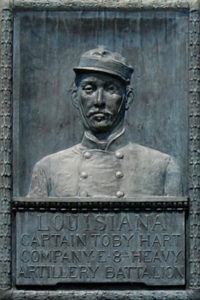Toby Hart
Toby Hart brought New Orleans its first professional sports franchise in 1887.

Courtesy of The Louisiana Endowment for the Humanities
Captain Toby Hart. Brewster, George T. (sculptor)
A modest granite marker stands at the corner of Jefferson Davis Parkway and Canal Street in New Orleans to commemorate the Civil War service of Captain Toby Hart; it was placed there in 1928 by his son. A more elaborate bronze relief plaque stands in the Louisiana Circle on the Vicksburg battlefield in Mississippi. Unlike the dubious connection of General Abner Doubleday to the origins of baseball in the United States, Hart was a Civil War veteran who brought New Orleans its very first professional sports franchise in 1887.
Hart was born on August 29, 1835, in Newberry, South Carolina, and his family moved to New Orleans around 1847, when he was twelve years old. Although little is known about his education, it is well documented that Hart was engaged in the business of painting houses and signs.
Along with William F. Tracey and others, the twenty-four-year-old Hart helped to establish the Lone Star Base Ball Club on September 15, 1859, one of the first organized baseball clubs, and he was a charter member of the Louisiana Base Ball Association. Their practices and games were held on the Delachaise Grounds, located near the present-day site of Touro Infirmary in Uptown New Orleans. The Delachaise Grounds were a little over a mile away from Hart’s home on Camp Street and Jackson Avenue.
In 1861 Hart enlisted in the Confederate Army and served briefly with forces tasked with the defense of New Orleans, but after the capture of New Orleans by Admiral David Farragut and the Union forces, Hart sought his release to form his own command. He organized Company E of the Eighth Battalion, Louisiana Heavy Artillery, and served as its captain. His unit placed the very first battery at Vicksburg in early 1863 as Union Gen. Ulysses Grant’s army was circling the city. He was captured and eventually paroled on May 8, 1865, in Meridian, Mississippi.
Hart made his way back to New Orleans and resumed his life as a painting contractor. Business was brisk and Hart was financially secure. In 1873 he designed and built a Gothic Revival home in Uptown New Orleans (2108 Palmer Ave.) on land he had acquired three years earlier. The Hart House has been on the National Register of Historic Places since 1984.
In 1877 he became one of the founders of the Phunny Phorty Phellows, a Mardi Gras krewe that followed the Krewe of Rex parade for the first time on March 5, 1878, and grew in prominence over the next twenty years. Hart was also involved with several other Mardi Gras-related groups.
It was also during this time that he was very active as an amateur baseball player and enthusiast. In 1883 he was selected to organize a committee to present an exhibition of the burgeoning new national pastime sport of “base ball” during the 1884 World Industrial and Cotton Centennial.
Hart was the principal shareholder of the New Orleans Base Ball Park, located on the north side of the 4500 block of Canal Street, bounded by Murat, Olympia, and Custom House (Iberville) Streets. Built in 1885, this facility catered to amateur and semi-professional teams, while professional teams would play at Sportsman’s Park at the foot of Canal Street. That facility was eventually developed into homes. As fate would have it, one of the first homeowners to purchase and build there would be Abner Powell, the first captain of the New Orleans Pelicans and later owner-manager of the club.
Hart also led the effort to obtain a franchise in the proposed Southern League being formed in 1885, but he could not muster enough support. He formed the New Orleans Base Ball Association and sponsored two teams in the Gulf Coast League to play two teams from Mobile, Alabama. By late 1886 Hart and his friends had enough financial support to secure a franchise in the Southern League; in 1887 the New Orleans Pelicans became the city’s first professional sports franchise.
In 1891 Hart was called as a witness in the murder trial of New Orleans Police Chief David Hennessey, being asked to testify to the sobriety of one of his employees, M. L. Peeler, who claimed to have witnessed the crime. The sensational trial led to the lynchings of Sicilian immigrants in what became known as the “Who killa da chief” scandal.
Hart died in New Orleans on December 27, 1907. At the time of his death, he was considered to be the most prominent sign painter and painting contractor in the South.
